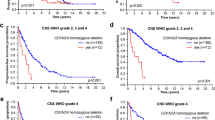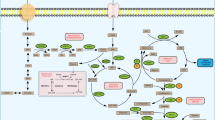Abstract
Purpose
Glioblastoma is an aggressive central nervous system tumor with a 5-year survival rate of < 10%. The standard therapy for glioblastoma is maximal safe resection, followed by radiation therapy and chemotherapy with temozolomide. New approaches to treatment of glioblastoma, such as targeting metabolism, have been studied. The object of this study is to evaluate whether asparagine could be a new target for treatment of glioblastoma.
Methods
We investigated a potential treatment for glioblastoma that targets the amino acid metabolism. U251, U87, and SF767 glioblastoma cells were treated with l-asparaginase and/or 6-diazo-5-oxo-l-norleucine (DON). l-asparaginase hydrolyzes asparagine into aspartate and depletes asparagine. l-asparaginase has been used for the treatment of acute lymphoblastic leukemia. DON is a glutamine analog that inhibits several glutamine-utilizing enzymes, including asparagine synthetase.
Results
Cell viability was measured after 72 h of treatment. MTS assay showed that l-asparaginase suppressed the proliferation of U251, U87, and SF767 cells in a dose-dependent manner. DON also inhibited the proliferation of these cell lines in a dose-dependent manner. Combined treatment with these drugs had a synergistic antiproliferative effect in these cell lines. Exogenous asparagine rescued the effect of inhibition of proliferation by l-asparaginase and DON. The expression of asparagine synthetase mRNA was increased in cells treated with a combination of l-asparaginase and DON. This combined treatment also induced greater apoptosis and autophagy than did single-drug treatment.
Conclusion
The results suggest that the combination of l-asparaginase and DON could be a new therapeutic option for patients with glioblastoma.





Similar content being viewed by others
References
Reni M, Mazza E, Zanon S, Gatta G, Vecht CJ (2017) Central nervous system gliomas. Crit Rev Oncol Hematol 113:213–234
Stupp R, Hegi ME, Mason WP, van den Bent MJ, Taphoorn MJ, Janzer RC, Ludwin SK, Allgeier A, Fisher B, Belanger K, Hau P, Brandes AA, Gijtenbeek J, Marosi C, Vecht CJ, Mokhtari K, Wesseling P, Villa S, Eisenhauer E, Gorlia T, Weller M, Lacombe D, Cairncross JG, Mirimanoff RO, European Organisation for Research and Treatment of Cancer Brain Tumour and Radiation Oncology Groups, National Cancer Institute of Canada Clinical Trials Group (2009) Effects of radiotherapy with concomitant and adjuvant temozolomide versus radiotherapy alone on survival in glioblastoma in a randomised phase III study: 5-year analysis of the EORTC-NCIC trial. Lancet Oncol 10(5):459–466
Ohba S, Hirose Y (2016) Current and future drug treatments for glioblastomas. Curr Med Chem 23:4309–4316
Agnihotri S, Zadeh G (2016) Metabolic reprogramming in glioblastoma: the influence of cancer metabolism on epigenetics and unanswered questions. Neuro Oncol 18:160–172
Strickland M, Stoll EA (2017) Metabolic reprogramming in Glioma. Front Cell Dev Biol 5:43
Dranoff G, Elion GB, Friedman HS, Bigner DD (1985) Combination chemotherapy in vitro exploiting glutamine metabolism of human glioma and medulloblastoma. Cancer Res 45(9):4082–4086
Yang C, Sudderth J, Dang T, Bachoo RM, McDonald JG, DeBerardinis RJ (2009) Glioblastoma cells require glutamate dehydrogenase to survive impairments of glucose metabolism or Akt signaling. Cancer Res 69:7986–7993
Li J, Song P, Zhu L, Aziz N, Zhou Q, Zhang Y, Xu W, Feng L, Chen D, Wang X, Jin H (2017) Synthetic lethality of glutaminolysis inhibition, autophagy inactivation and asparagine depletion in colon cancer. Oncotarget 8:42664–42672
Yuneva M, Zamboni N, Oefner P, Sachidanandam R, Lazebnik Y (2007) Deficiency in glutamine but not glucose induces MYC-dependent apoptosis in human cells. J Cell Biol 178(1):93–105
Choi BH, Coloff JL (2019) The diverse functions of non-essential amino acids in cancer. Cancers 11:E675
Fung MKL, Chan GC (2017) Drug-induced amino acid deprivation as strategy for cancer therapy. J Hematol Oncol 10:144
Gross MI, Demo SD, Dennison JB, Chen L, Chernov-Rogan T, Goyal B, Janes JR, Laidig GJ, Lewis ER, Li J, Mackinnon AL, Parlati F, Rodriguez ML, Shwonek PJ, Sjogren EB, Stanton TF, Wang T, Yang J, Zhao F, Bennett MK (2014) Antitumor activity of the glutaminase inhibitor CB-839 in triple-negative breast cancer. Mol Cancer Ther 13:890–901
Weerapana E, Imperiali B (2006) Asparagine-linked protein glycosylation: from eukaryotic to prokaryotic systems. Glycobiology 16:91R–101R
Krall AS, Xu S, Graeber TG, Braas D, Christofk HR (2016) Asparagine promotes cancer cell proliferation through use as an amino acid exchange factor. Nat Commun 7:11457
Lomelino CL, Andring JT, McKenna R, Kilberg MS (2017) Asparagine synthetase: function, structure, and role in disease. J Biol Chem 292:19952–19958
Shrivastava A, Khan AA, Khurshid M, Kalam MA, Jain SK, Singhal PK (2016) Recent developments in l-asparaginase discovery and its potential as anticancer agent. Crit Rev Oncol Hematol 100:1–10
Story MD, Voehringer DW, Stephens LC, Meyn RE (1993) l-asparaginase kills lymphoma cells by apoptosis. Cancer Chemother Pharmacol 32(2):129–133
Kisner DL, Catane R, Muggia FM (1980) The rediscovery of DON (6-diazo-5-oxo-l-norleucine). Recent Results Cancer Res 74:258–263
Karpel-Massler G, Ramani D, Shu C, Halatsch ME, Westhoff MA, Bruce JN, Canoll P, Siegelin MD (2016) Metabolic reprogramming of glioblastoma cells by l-asparaginase sensitizes for apoptosis in vitro and in vivo. Oncotarget 7:33512–33528
Pavlova NN, Thompson CB (2016) The emerging hallmarks of cancer metabolism. Cell Metab 23:27–47
Chen Q, Ye L, Fan J, Zhang X, Wang H, Liao S, Song P, Wang Z, Wang S, Li Y, Luan J, Wang Y, Chen W, Zai W, Yang P, Cao Z, Ju D (2017) Autophagy suppression potentiates the anti-glioblastoma effect of asparaginase in vitro and in vivo. Oncotarget 8(53):91052–91066
Pavlova NN, Hui S, Ghergurovich JM, Fan J, Intlekofer AM, White RM, Rabinowitz JD, Thompson CB, Zhang J (2018) As extracellular glutamine levels decline, asparagine becomes an essential amino acid. Cell Metab 27:428–438.e5
Balasubramanian MN, Butterworth EA, Kilberg MS (2013) Asparagine synthetase: regulation by cell stress and involvement in tumor biology. Am J Physiol Endocrinol Metab 304:E789–E799
Rabinowitz JD, White E (2010) Autophagy and metabolism. Science 330(6009):1344–1348
Pascolo S (2016) Time to use a dose of chloroquine as an adjuvant to anti-cancer chemotherapies. Eur J Pharmacol 771:139–144
Panosyan EH, Wang Y, Xia P, Lee WN, Pak Y, Laks DR, Lin HJ, Moore TB, Cloughesy TF, Kornblum HI, Lasky JL 3rd (2014) Asparagine depletion potentiates the cytotoxic effect of chemotherapy against brain tumors. Mol Cancer Res 12:694–702
Sanghez V, Chen M, Li S, Chou TF, Iacovino M, Lin HJ, Lasky JL, Panosyan EH (2018) Efficacy of asparaginase Erwinia chrysanthemi with and without temozolomide against glioma cells and intracranial mouse medulloblastoma. Anticancer Res 38:2627–2634
Hawkins DS, Park JR, Thomson BG, Felgenhauer JL, Holcenberg JS, Panosyan EH, Avramis VI (2004) Asparaginase pharmacokinetics after intensive polyethylene glycol-conjugated l-asparaginase therapy for children with relapsed acute lymphoblastic leukemia. Clin Cancer Res 10:5335–5341
Vieira Pinheiro JP, Wenner K, Escherich G, Lanvers-Kaminsky C, Würthwein G, Janka-Schaub G, Boos J (2006) Serum asparaginase activities and asparagine concentrations in the cerebrospinal fluid after a single infusion of 2,500 IU/m(2) PEG asparaginase in children with ALL treated according to protocol COALL-06-97. Pediatr Blood Cancer 46(1):18–25
Acknowledgements
The authors are grateful to Ms. Tomoko Suzuki and Fujiko Sueishi for their excellent technical assistance to our study.
Author information
Authors and Affiliations
Contributions
SO (Hypothesis, data analysis, writing of original draft); YH (critical revision of manuscript)
Corresponding author
Ethics declarations
Conflict of interest
The authors declare that they have no conflict of interest.
Additional information
Publisher's Note
Springer Nature remains neutral with regard to jurisdictional claims in published maps and institutional affiliations.
Rights and permissions
About this article
Cite this article
Ohba, S., Hirose, Y. l-asparaginase and 6-diazo-5-oxo-l-norleucine synergistically inhibit the growth of glioblastoma cells. J Neurooncol 146, 469–475 (2020). https://doi.org/10.1007/s11060-019-03351-4
Received:
Accepted:
Published:
Issue Date:
DOI: https://doi.org/10.1007/s11060-019-03351-4




